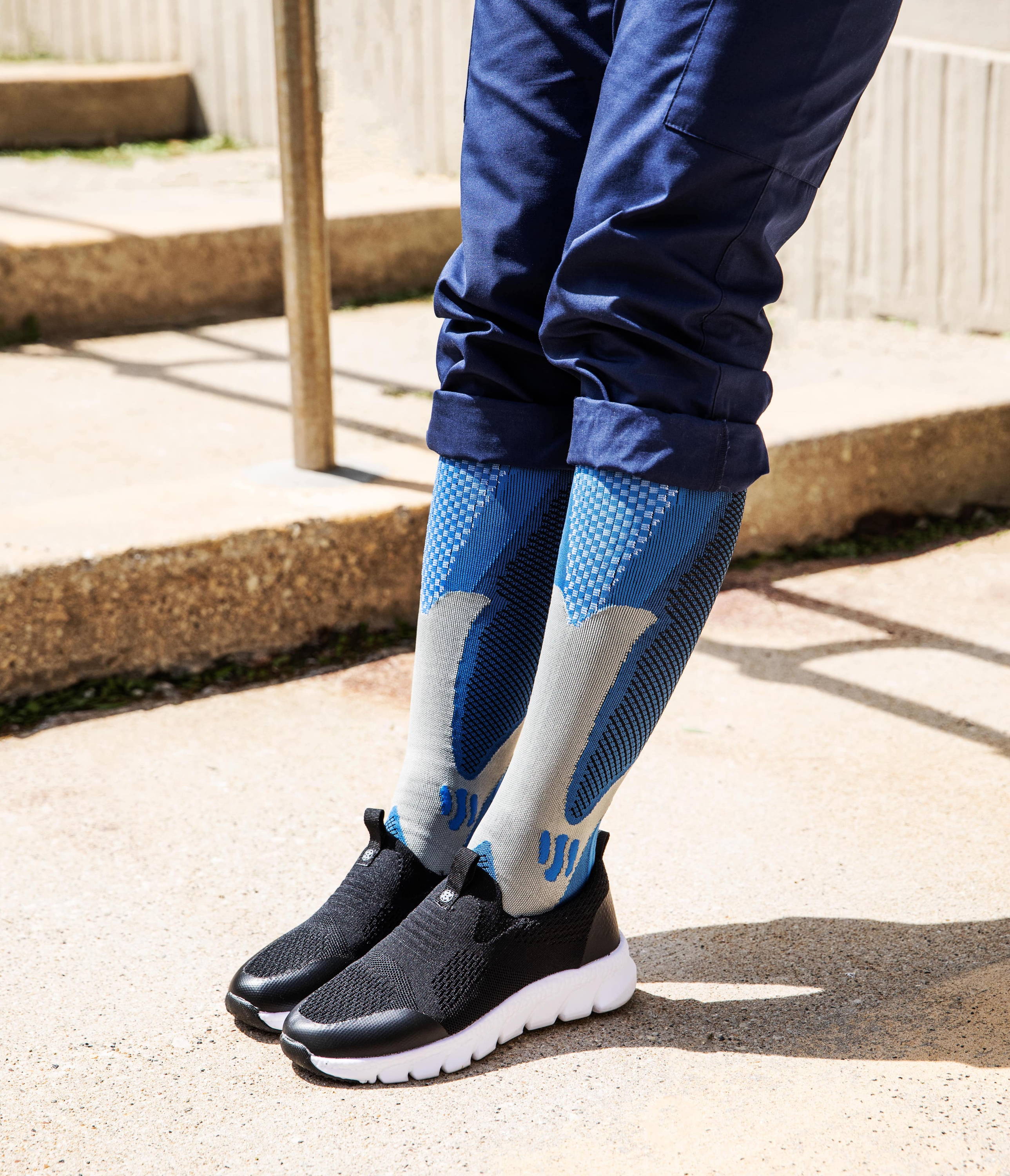
Wearing Compression Socks While Sleeping
If you often endure the pain of varicose veins or chronically suffer from cold feet at night, finding the right pair of socks could provide the relief you need. According to The Sleep Doctor, wearing regular crew socks to bed can help you fall asleep faster, stay asleep longer, and wake up less throughout the night.
But is it just as beneficial to wear compression socks while sleeping? Why would anyone choose to wear compression socks over ordinary socks? The guide below discusses:
- The various benefits of wearing compression socks to bed
- How to choose the right compression socks for sleeping
- Who should avoid wearing compression socks at night
Can You Sleep in Compression Socks?
Yes, you can safely sleep in compression socks, but there are few advantages to doing so. Though they aid circulation while you’re up and moving around, moderate to firm compression socks can cause inflammation if you wear them at night. When you’re lying horizontal, your circulatory system no longer has to fight gravity, so extra pressure can disrupt circulation and cause tingling or numbness.
If you’re more comfortable wearing these socks to sleep, choose a pair that delivers low compression—no more than 15mmHg. Anything labeled 20 to 30 mmHg should only be worn during the day.
Benefits of Sleeping in Compression Socks
For those who are generally healthy, there are few advantages to sleeping in compression socks. Athletes and those who work on their feet all day get the most benefit from wearing them while they’re active, not at rest.
However, there are a few specific cases in which it’s okay to sleep in higher-pressure compression socks, including:
- Hospital staff napping between shifts
- Travelers sleeping upright on airplanes
- Recovery from leg or spinal surgery
- Conditions that affect circulation

Improves Poor Circulation
One of the most common reasons individuals wear compression socks is to aid circulation. While standing or sitting, the light pressure from these socks helps blood circulate more smoothly and efficiently. When lying down or sleeping, there’s no need to work against gravity—so compression socks offer little to no benefit.
However, graduated pressure from compression socks may help those with blood pressure conditions like orthostatic hypotension. This low blood pressure disorder causes dizziness or even fainting when individuals move from lying or sitting to standing. Compression socks increase blood flow and help alleviate this symptom.
Protects Sore Spots
Individuals with venous conditions sometimes develop ulcers or sore spots due to a build-up of pressure inside the veins in their legs. Compression socks encourage better blood flow and protect tender areas from being chafed or bumped while sleeping. This combination of benefits helps the sores heal and prevents new ones from developing.
Reduces Swelling
Inflammation relief is one of the most common reasons people wear compression socks, especially while traveling. Sitting for long periods in a car, bus, or airplane can cause fluid to build up in your feet, ankles, and lower legs, resulting in uncomfortable swelling. Compression socks help keep the fluids flowing and significantly reduce inflammation.
Are There Any Negatives to Sleeping in Compression Socks?
Though sleeping in low-pressure compression socks is generally safe, there are a few precautions you should take to protect your feet and legs. Wearing the same socks too much can cause problems, and you’ll need to stop wearing compression socks until you heal.
Irritation & Rubbing
Compression socks hug the leg more tightly than ordinary crew socks, which are pressed firmly against your skin while wearing them. Wearing the same socks for too long can lead to chafing that irritates the skin and causes raw areas or even sores.
Areas at the most risk of rubbing and chafing include the ankles, the shin, and the area just under the sock cuff. Left untreated, these areas may even become infected.
The best way to prevent irritation and rubbing is to change your socks daily and bathe or shower frequently to remove built-up dirt and oil and shed skin cells. This allows your skin to breathe and reduces the likelihood of sores or infections.
Infection If You Don’t Wash Them
Wearing the same socks day in and day out—whether compression socks or not—can cause bacteria and fungus to build up in the fabric. This build-up can cause infections like infected sores on your legs and athlete's foot between your toes.
The best way to prevent this from happening is to change into fresh socks at least once every 24 hours and wash each pair before you wear them again. Regular cleaning rids the fabric of sweat, dirt, oil, and microbes that cause these infections.
In Conclusion: You Can Wear Compression Socks to Bed
Compression socks—like those produced by Nurse Yard—are excellent for napping on airplanes, resting between hospital shifts, and supporting recovery after specific surgical procedures.
In fact, our socks are many individuals’ first choice when it comes to alleviating joint pain and increasing personal comfort.
Our socks protect you from foot to knee with our unique design hack, which includes:
- Supported arches
- Cushioned ankles
- Roomier foot fit
- Wave-knit for graduated pressure
- No-slip, anti-chafe sock cuff
Nurse Yard compression socks provide the support you need for healthy, consistent circulation and inflammation relief.
